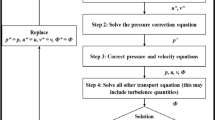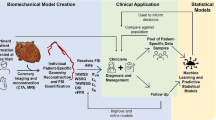Abstract
Atherosclerotic disease progression in coronary arteries is influenced by wall shear stress. To compute patient-specific wall shear stress, computational fluid dynamics (CFD) is required. In this study we propose a method for computing the pressure-drop in regions proximal and distal to a plaque, which can serve as a boundary condition in CFD. As a first step towards exploring the proposed method we investigated ten straightened coronary arteries. First, the flow fields were calculated with CFD and velocity profiles were fitted on the results. Second, the Navier–Stokes equation was simplified and solved with the found velocity profiles to obtain a pressure-drop estimate (Δp (1)). Next, Δp (1) was compared to the pressure-drop from CFD (Δp CFD) as a validation step. Finally, the velocity profiles, and thus the pressure-drop were predicted based on geometry and flow, resulting in Δp geom. We found that Δp (1) adequately estimated Δp CFD with velocity profiles that have one free parameter β. This β was successfully related to geometry and flow, resulting in an excellent agreement between Δp CFD and Δp geom: 3.9 ± 4.9% difference at Re = 150. We showed that this method can quickly and accurately predict pressure-drop on the basis of geometry and flow in straightened coronary arteries that are mildly diseased.







Similar content being viewed by others
References
Bessems, D., M. Rutten, and F. Van De Vosse. A wave propagation model of blood flow in large vessels using an approximate velocity profile function. J. Fluid Mech. 580:145–168, 2007.
Falk, E., P. K. Shah, and V. Fuster. Coronary Plaque Disruption. Circulation 92(3):657–671, 1995.
Formaggia, L., et al. On the coupling of 3D and 1D Navier-Stokes equations for flow problems in compliant vessels. Comput. Methods Appl. Mech. Eng. 191:561–582, 2001.
Fukumoto, Y., et al. Localized elevation of shear stress is related to coronary plaque rupture: a 3-dimensional intravascular ultrasound study with in vivo color mapping of shear stress distribution. J. Am. Coll. Cardiol. 51(6):645–650, 2008.
Gijsen, F. J. H., et al. Shear stress and advanced atherosclerosis in human coronary arteries. J. Biomech. 46(2):240–247, 2013.
Girasis, C., et al. Novel bifurcation phantoms for validation of quantitative coronary angiography algorithms. Catheter. Cardiovasc. Interv. 77(6):790–797, 2011.
Gould, K. L., K. O. Kelley, and E. L. Bolson. Experimental validation of quantitative coronary arteriography for determining pressure-flow characteristics of coronary stenosis. Circulation 66(5):930–937, 1982.
Huberts, W., et al. A pulse wave propagation model to support decision-making in vascular access planning in the clinic. Med. Eng. Phys. 34(2):233–248, 2012.
Hughes, J. R., and J. Lubliner. On the One-Dimensional Theory of Blood Flow in the Larger Vessels. Math. Biosci. 18:161–170, 1973.
Huo, Y., and G. S. Kassab. Pulsatile blood flow in the entire coronary arterial tree: theory and experiment. Am. J. Phys. Heart Circ. Physiol. 291(3):H1074–H1087, 2006.
Huo, Y., and G. S. Kassab. A hybrid one-dimensional/Womersley model of pulsatile blood flow in the entire coronary arterial tree. Am. J. Phys. Heart Circ. Phys. 292(6):H2623–H2633, 2007.
Kim, H. J., et al. On coupling a lumped parameter heart model and a three-dimensional finite element aorta model. Ann. Biomed. Eng. 37(11):2153–2169, 2009.
Kim, H. J., K. E. Jansen, and C. A. Taylor. Incorporating autoregulatory mechanisms of the cardiovascular system in three-dimensional finite element models of arterial blood flow. Ann. Biomed. Eng. 38(7):2314–2330, 2010.
Kroon, W., et al. A numerical method of reduced complexity for simulating vascular hemodynamics using coupled 0D lumped and 1D wave propagation models. Comput. Math. Methods Med. 2012:156094, 2012.
Mollet, N. R., et al. Noninvasive assessment of coronary plaque burden using multislice computed tomography. Am. J. Cardiol. 95(10):1165–1169, 2005.
Olufsen, M. S. Structured tree outflow condition for blood flow in larger systemic arteries Structured tree outflow condition for blood flow in larger systemic arteries. Am. J. Physiol. Heart Circ. Physiol. 276:257–268, 1999.
Pahlevan, N. M., et al. A physiologically relevant, simple outflow boundary model for truncated vasculature. Ann. Biomed. Eng. 39(5):1470–1481, 2011.
Pijls, N. H., et al. Measurement of fractional flow reserve to assess the functional severity of coronary-artery stenoses. New Engl. J. Med. 334(26):1703–1708, 1996.
Reymond, P., et al. Validation of a one-dimensional model of the systemic arterial tree. Am. J. Physiol. Heart Circ. Physiol. 297(1):H208–H222, 2009.
Samady, H., et al. Coronary artery wall shear stress is associated with progression and transformation of atherosclerotic plaque and arterial remodeling in patients with coronary artery disease. Circulation 124(7):779–788, 2011.
Schaar, J. A., et al. Terminology for high-risk and vulnerable coronary artery plaques. Report of a meeting on the vulnerable plaque, June 17 and 18, 2003, Santorini, Greece. Eur. Heart J. 25(12):1077–1082, 2004.
Schrauwen, J., et al. Geometry-based pressure drop prediction in mildly diseased human coronary arteries. J. Biomech. 47(8):1810–1815, 2014.
Stone, G. W., et al. A prospective natural-history study of coronary atherosclerosis. New Engl. J. Med. 364(3):226–235, 2011.
Stone, P. H., et al. Prediction of progression of coronary artery disease and clinical outcomes using vascular profiling of endothelial shear stress and arterial plaque characteristics: the PREDICTION Study. Circulation 126(2):172–181, 2012.
Taylor, C. A., and C. A. Figueroa. Patient-specific modeling of cardiovascular mechanics. Ann. Rev. Biomed. Eng. 11:109–134, 2009.
Tu, S., et al. In vivo assessment of bifurcation optimal viewing angles and bifurcation angles by three-dimensional (3D) quantitative coronary angiography. Int. J. Cardiovasc. Imaging 28(7):1617–1625, 2012.
Van de Vosse, F. N., and N. Stergiopulos. Pulse wave propagation in the arterial tree. Ann. Rev. Fluid Mech. 43(1):467–499, 2011.
Van der Giessen, A. G., et al. The influence of boundary conditions on wall shear stress distribution in patients specific coronary trees. J. Biomech. 44(6):1089–1095, 2011.
Van der Horst, A. et al. Towards patient-specific modeling of coronary hemodynamics in healthy and diseased state. Comput. Math. Methods. Med. 15, 2013.
Vignon-Clementel, I. E., et al. Outflow boundary conditions for three-dimensional finite element modeling of blood flow and pressure in arteries. Comput. Methods Appl. Mech. Eng. 195(29–32):3776–3796, 2006.
Virmani, R., et al. Lessons from sudden coronary death: a comprehensive morphological classification scheme for atherosclerotic lesions. Arterioscler. Thromb. Vasc. Biol. 20:1262–1275, 2000.
Wan, J., et al. A one-dimensional finite element method for simulation-based medical planning for cardiovascular disease. Comput. Methods Biomech. Biomed. Eng. 5(3):195–206, 2002.
Wentzel, J. J., et al. Endothelial shear stress in the evolution of coronary atherosclerotic plaque and vascular remodelling: current understanding and remaining questions. Cardiovasc. Res. 96(2):234–243, 2012.
Young, D., and F. Tsai. Flow characteristics in model of aterial stenosis—I steady flow. J. Biomech. 6(4):395–410, 1973.
Young, D., and F. Tsai. Flow characteristics in models of arterial stenoses—II unsteady flow. J. Biomech. 6(1955):547–559, 1973.
Acknowledgments
This research was performed within the framework of the CARISMA-program of STW (Stichting Wetenschap en Techniek), as well as funded by STW.
Author information
Authors and Affiliations
Corresponding author
Additional information
Associate Editor Umberto Morbiducci oversaw the review of this article.
Rights and permissions
About this article
Cite this article
Schrauwen, J.T.C., Koeze, D.J., Wentzel, J.J. et al. Fast and Accurate Pressure-Drop Prediction in Straightened Atherosclerotic Coronary Arteries. Ann Biomed Eng 43, 59–67 (2015). https://doi.org/10.1007/s10439-014-1090-9
Received:
Accepted:
Published:
Issue Date:
DOI: https://doi.org/10.1007/s10439-014-1090-9




